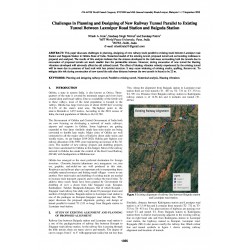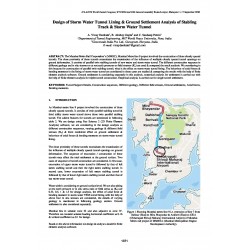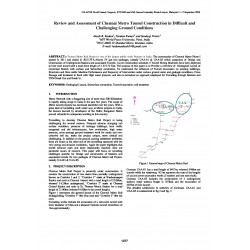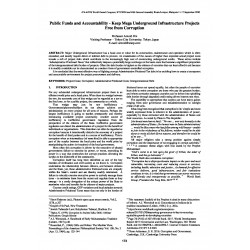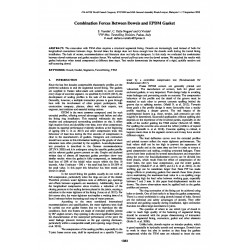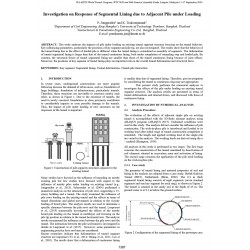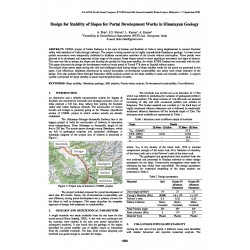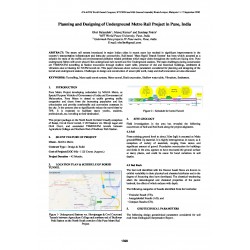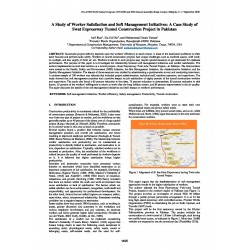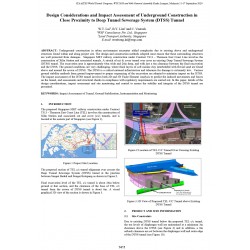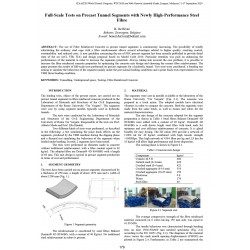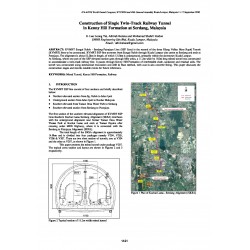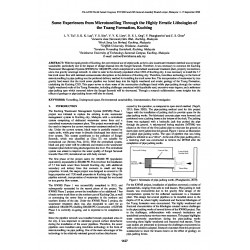No document
Search & filter
Search for a publication
Search & filter
World Tunnelling Congress
WTCThere are 1984 documents.
-
Challenges in Planning and Designing of New Railway Tunnel Parallel to Existing Tunnel between Laxmipur Road Station...
Abstract: This paper discusses challenges in planning, designing of new railway track parallel to existing track between Laxmipur road Station and Baiguda Station in Odisha State of India. Numerical model of the existing tunnel, proposed tunnel and surrounding rockmass is prepared and analysed. The results of this analysis indicate that the stresses developed in the rock mass surrounding both the tunnels...
0,00 € -
Geotechnical Design of Bored Tunnels for Pune Phase 1 Underground section
Abstract: Pune is ranked 9th most population in India and in last decade the city has witnessed a rise in population as the people are migrating from different part of the country for job opportunities, which has put the city travel infrastructure to stress. There was a growing need for mass rapid transportation, however most of project is elevated viaduct consisting of prestressed concrete girders...
0,00 € -
Case Study on the Design of Tunnel by NATM in Urban Environment
Abstract: The main objective of this paper is to study the design philosophy of the primary lining of NATM tunnel for an underground metro station at Mumbai Metro Line 3. The underground station consists of a cut and cover station and NATM tunnel construction. The location consists of the varying geology from grade II rock to weathered rock. The paper covers the geotechnical parameters, construction...
0,00 € -
Design of Storm Water Tunnel Lining and Ground Settlement Analysis of Stabling Track and Storm Water Tunne
Abstract: The Mumbai Metro Rail Corporation’s (MMRC), Mumbai Metro line 9 project involved the construction of three closely spaced tunnels. The close proximity of these tunnels necessitates the examination of the influence of multiple closely spaced tunnel openings on ground deformation. It consists of parallel twin stabling tunnels of new metro and storm water tunnel. The different construction...
0,00 € -
Review and Assessment of Chennai Metro Tunnel Construction in Difficult and Challenging Ground Conditions
Abstract: Chennai Metro Rail Project is one of the largest public work Projects in India. The construction of Chennai Metro Phase-I started in 2011 and ended in 2015.TTA-Afcons JV got two packages, namely UAA-01 & UAA-05 which comprises of Design and Construction of Underground Stations and associated Tunnels. As per construction schedule, 5 Tunnel Boring Machines have been deployed to bore twin...
0,00 € -
Public Funds and Accountability - Keep Mega Underground Infrastructure Projects Free from Corruption
Abstract: Major Underground Infrastructure has a basic cost or value for its construction, maintenance and operation which is often exceeded, and mostly require direct or indirect debt to procure. An examination of the causes of higher than expected actual project costs reveals a raft of project risks which contribute to the increasingly high cost of constructing underground works. These extras include...
0,00 € -
Combination Forces between Dowels and EPDM Gasket
Abstract: The excavation with TBM often requires a structural segmental lining. Dowels are increasingly used instead of bolts for longitudinal connections between rings. Several times the design does not focus enough how the dowels work during the tunnel lining installation. The lack of norms, recommendations and literature does not help the designers. In this study we evaluated the combination between...
0,00 € -
Investigation on Response of Segmental Lining due to Adjacent Pile under Loading
Abstract: This study analyses the impacts of pile under loading on existing tunnel segment structure focusing on the tunnel behavior. Key influencing parameters, particularly the positions of key segment and pile tip, are also investigated. The results show that the behavior of the tunnel lining due to the effect of loaded pile is different when the tunnel lining is considered as assembly of segments....
0,00 € -
Design for Stability of Slopes for Portal Development Works in Himalayan Geology
Abstract: USBRL project of Indian Railways in the state of Jammu and Kashmir of India is being implemented to connect Kashmir valley with mainland of India through railways. The project is being carried out in highly unpredictable Himalayan geology. At some tunnel portals excavations were temporarily stabilized to facilitate construction activities of the tunnels without interruption. These portals were...
0,00 € -
Planning and Designing of Underground Metro Rail Project in Pune, India
Abstract: The metro rail system introduced in major Indian cities in recent years has resulted in significant improvements in the country’s transportation infrastructure and intra-city connectivity. Rail-based ‘Mass Rapid Transit System’ has been widely accepted as a solution for most of the traffic and environmental pollution related problems which major cities throughout the world are facing now. Pune...
0,00 € -
A Study of Worker Satisfaction and Soft Management Initiatives: A Case Study of Swat Expressway Tunnel Construction...
Abstract: Successful project delivery depends upon the workers' efficiency to much extant. A team of the motivated workforce is often more focused and perform tasks safely. Workers in tunnel construction projects face unique challenges such as confined spaces, shift work, no sunlight, and less supply of fresh air, etc. Workers involved in such projects may require special measures to get motivated for...
0,00 € -
Design Considerations and Impact Assessment of Underground Construction in Close Proximity to Deep Tunnel Sewerage...
Abstract: Underground construction in urban environment encounter added complexity due to existing above and underground structures found within and along project site. The design and construction methods adopted must ensure that these surrounding structures are well protected from damages. Singapore MRT railway construction under Contract T313 - Thomson East Coast Line involves the construction of Xilin...
0,00 € -
Full-Scale Tests on Precast Tunnel Segments with Newly High Performance Steel Fibre
Abstract: The use of Fibre Reinforced Concrete in precast tunnel segments is continuously increasing. The possibility of totally substituting the ordinary steel cage with a fibre reinforcement allows several advantages related to higher quality, cracking control, sustainability and reduced costs. A new guideline concerning the use of FRC precast segment has been recently published to provide detail state...
0,00 € -
Interface Shearing Characteristic between Biopolymer-treated Soil and Underground Structures
Abstract: Recently, there have been a lot of applications of environmentally friendly microbial biopolymer as a new construction material for geotechnical engineering practices including soil stabilisation, slope protection, and ground injection. Biopolymer is known to have excellent geotechnical properties improvement effect such as shear strength properties enhancement and hydraulic conductivity...
0,00 € -
Construction of Single Twin-Track Railway Tunnel in Kenny Hill Formation at Serdang, Malaysia
Abstract: KVMRT Sungai Buloh - Serdang-Putrajaya Line (SSP Line) is the second of the three Klang Valley Mass Rapid Transit (KVMRT) lines to be constructed. KVMRT SSP line traverses from Sungai Buloh through Kuala Lumpur city centre to Serdang and ends at Putrajaya. The alignment is about 52.2km in length, of which 13.5km is underground, primarily within the downtown Kuala Lumpur. At Serdang, where one...
0,00 € -
Some Experiences from Microtunnelling through the Highly Erratic Lithologies of the Tuang Formation, Kuching
Abstract: With the rapid growth of Kuching, the conventional use of septic tanks as the in-situ wastewater treatment method was no longer sustainable, particularly due to the impact of sludge disposal into the Sungei Sarawak. Therefore, it was necessary to construct the Kuching Wastewater Management System (KWMS) for 100,000 PE, which comprised of a centralised wastewater treatment plant, property...
0,00 €

